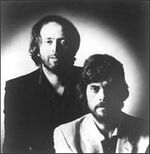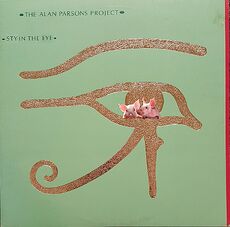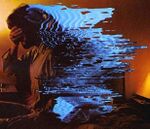The Alan Parsons Project

The Alan Parsons Project (also known as The Alan Parsons Project; Alan Parsons Project, The; Project, Parson, Alan, The; The Poor Man's Yes, The Thinking Man's ELO, and The Real Slim Shady) were an English Prog rock band based in England, somewhere near Abbey Road Studios.
Made up of two brothers, Eric Woolfson Project and his rather mysterious brother, Alan Parsons Project, the band redefined Prog during the 70s and 80s, then redefined themselves, then redefined redefining themselves, then redefined beards.
Perhaps the most notable fact about Alan's history is that he was assistant engineer on many of The Beatles's's albums whilst they were being recorded at Abbey Road studios. This fact will be the first thing any Project fan will tell you, also the second, third and fourth things, and then repeated every twelve to fifteen minutes until you kill them, and even then until you hide the body. This article, in honor of Project fandom, will follow suit.
History[edit]
Formation and early days[edit]
The Alan Parsons Project, the band, was started by the brothers Project: Alan Parsons Project and Eric Woolfson Project, soon after Alan became tired of endlessly engineering albums for The Beatles at Abbey Road studios. Eric wanted to write, but couldn't play; Alan could play, but couldn't write. Even after considering the fact that they were brothers, it was a marriage made in Heaven, or at least at Elektra/Asylum records.
Soon after they decided to form a band, they ran into what could have been a fatal obstacle: despite having a single singer/songwriters talent between them, they actually had no ideas for music … not a thing. After a night brainstorming, they both it upon an idea, as a gestalt entity, as it were: They'd create concept albums based on popular works of literature. This provided a thematic hook to hand thier musical hats on; moreover, it would fool thousands of eager book buyers into buying their albums by mistake.
First albums[edit]
Thus was borne the first two albums by the Group; Tales of Mystery and Imagination, Edgar Allan Poe (only on a record), and I Robot, You Jane, mocking the styles of Poe and Isaac Asimov respectively (and also without respect). The group's opening gambit worked, and by the time of the third album, Surprise, We're Actually A Band (Had You Worked That Out?), had – amazingly enough, built a fan base.
Certainly, the fan base was confused SF geeks and other Prog Rock wierdos who'd thought they'd bought Pink Floyd and Yes albums, but they liked what they heard, even though they couldn't really be sure of what it was they were listening to.
This was all enabled by the fact that, as a youth, young Alan was an assistant engineer under (and above, and sometimes in awkward positions) The Beatles at Abbey Road Studios. In case anyone forgot.
The semi-obscure years[edit]
As befit their Zelig-like persona, the bad formed themselves like an amoeba around every theme they tackled, becoming the theme but also staying uniquely themselves, but just in a way you couldn't quite put your finger on. Through the albums Pyramidscheme, Eve (Not The Douche or the Cigarette), and The Credit Of A Friendly Card, they perfected a style that came close to convincing their fans that they were the band they thought they had come to see. During this period, people thought they were viewing anyone from Yes to Jethro Tull to not only Emerson, Lake and Palmer to just Emerson and Lake without the Palmer.
This almost backfired once when, in a December 1978 concert at Madison Square Garden, the band went so far into Palmer that they started doing Robert Palmer, and the cognitive dissonance caused people to nearly riot. A release of Nag Champa incense and single malt scotch calmed the mob a great deal, though many of them remain addicted to love to this day, and are still in rehab.
The commercial years[edit]
After a long time building up a devoted (if bemused) hard core of fans, the Project went through a morphing into a more commercial sound which usually occurs, music anthropologist find, about three-quarters the way to final irrelevancy. To do this the band assumed a more solid form an identifiable image with the introduction of actual instruments.
A horn section was also added, which fleshed out the band's actual sound quite a bit, though many people tended to confuse them with Chicago from then on out.
Another innovation for the band was to begin releasing actual albums. Seeming to resemble any other band the listeners pleased saved the group a great deal of money by not actually having to release physical disks. With the next release, Sty in the Eye, an actual vinyl record was released, causing such remarkable singles as the title track, "Psychiatristbabble", and "Old and Creaky" to ascend the charts like never before.
With the newfound popularity, however, came the demand for moar touring and the band, thus far having obscured their own identities to the point where people were not completely sure they'd seen them at all during a performance, had to have an identifiable face to go along with the new style. This was achieved by an ever-changing rotation of performers, including David Hasselhoff, Cthulhu, Tina Turner, Ian Anderson, Your Mom, and four Eric Claptons.
It was this period that gave the band it's last and most well-known nickname, "Prog Rock Menudo".
Decline and fall[edit]
The band's last three albums, Ammonia Avenue, Stereotomy, and Gaudi, while meeting with critical acclaim (Robert Christgau, self-appointed "Dean of American Rock Critics" having lauded them by celebrating their use of actual musical notes) did not fare so well with the public after the public began to wake up and see what sort of a laugh the Project brothers had of them. As a matter of fact, the last album, 1985's Gaudi sold only seven copies, three of which were bought by a reclusive stamp collector in Des Moines, Iowa. Fortunately for the band, however, that stamp collector paid USD$2,350,000 for each copy, enabling Eric and Alan to enter hiding and erase most tracks of their existence.
Recent research has uncovered, however, that Eric Woolfson Project has moved to the steppes of Russia to a Buddhist monastery there, billing himself as the "Hello Dolly Lama", whereas Alan was finally disassembled in 1997 and remains in a storage unit somewhere outside Croydon, England, being saved against the time he will have to ride out and save the realm once again, or at least, assistant-engineer and the Abbey-freaking-Road Studios.
The Alan Parsons Project controversy[edit]
A source of controversy amongst fans is the actual nature of Alan Parsons Project himself. It's conjectured, actually, that Alan's name springs from the fact that he is actually a cloned or artificial being, assembled in the basement labs of Abbey-goddamn-Road Studios. Notes from early digs in the ruins of the studio seem to suggest that the Alan Parsons Project wasn't so much a band as a Project to create Alan Parsons (the fact he remains in storage in South London is considered a coincidence, and perhaps he slipped on a strumpet or something).
Though there is no solid evidence to go on, this article is happy to wildly spread irresponsible rumor just to see what happens, and to get a laugh or two.
Carry on.
He Was Assistant Engineer at Abbey Road Studios[edit]
This section was created to make sure we're up to quota on the number of times this trivium should be repeated in any discussion of Alan Parsons Project. We should be up to quota now.
Is this the last word on that subject?
No. Not by a long shot.
Discography[edit]
- Tales of Mystery and Imagination (1976)
- Tales of the Obvious and the Banal (1976)
- I Robot, You Jane (1977)
- Pyramid Scheme (1978, twice in 1982, and again in 1985)
- Summer's Eve (1979)
- The Credit of a Friendly Card (18% APR)
- Sty in the Eye (1982)
- Parson's Ammonia (1984)
- No Culture, Just Vulture (1984)
- Stereophlebotomy (1985)
- Gaudy (1987)


